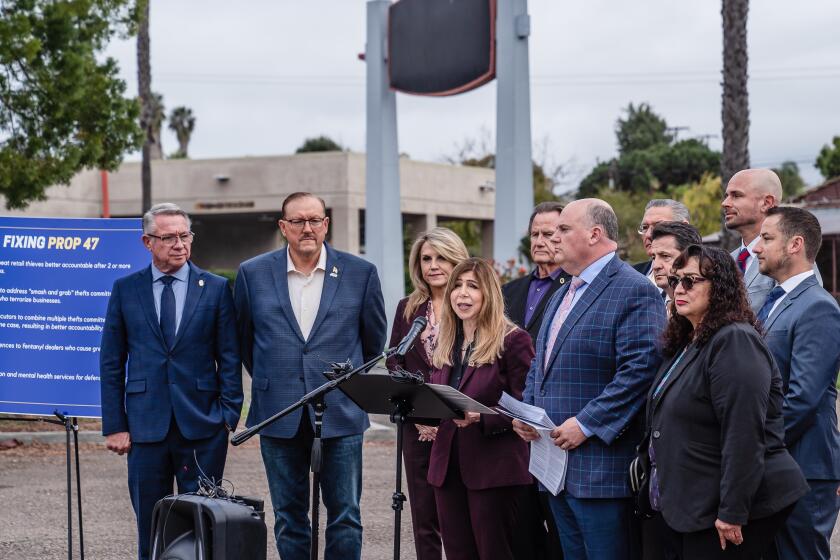8 ways police can spy on crime, and you
Does law enforcement’s quest for safety infringe on people’s civil liberties?
That’s the question privacy advocates are asking as technology continues to make it easier for police agencies to monitor citizens.
From radar devices that can see through walls to a network of microphones that reports shootings to officers, here are eight ways the police can keep an eye on you, and why some groups find them alarming.
1. Range-R
What it is: The Range-R looks like a high-tech stud-finder, but it pinpoints people. The radar device uses radio waves to “see” through walls to locate people inside a structure. It can pick up on movements as slight as human breathing to detect the location of a person up to 50 feet away, but it doesn’t provide an image of what’s inside. The device was devised for troops in Iraq and Afghanistan, and it’s been used by U.S. law enforcement agencies since at least 2012. A unit costs about $6,000.
Why you’ll care: Privacy advocates have concerns about use of the device without a search warrant. A Kansas federal appeals court brought the issue to light in December. A deputy U.S. Marshal – who had a warrant for a parolee’s arrest but no search warrant – used the Range-R to determine if anyone was inside a Wichita home where authorities suspected the felon lived. The parolee’s defense attorney tried to get a charge thrown out because of the radar’s use. While the charges were upheld, the court’s ruling said the “government’s warrantless use of such a powerful tool to search inside homes poses grave Fourth Amendment questions.”
2. Stingray
What it is: The Stingray masquerades as a cellphone tower, forcing all nearby cellphones to connect to it. It’s usually mounted in a law enforcement vehicle. Coupled with an antenna, police can use the Stingray to determine where a mobile phone is in real time. Phones also stream data to the device, including the phone and identification numbers, which can be used to get past call and text data and any dialed numbers. The technology was initially developed for military and spy agencies and can cost as much as $400,000.
Why you’ll care: Law enforcement agencies, including local ones, have been extremely secretive about whether and how they use Stingray technology. A civil-rights group is suing the San Diego Police Department for its refusal to turn over information about the device. Police in other parts of the country have admitted using the technology without a warrant, which advocacy organizations argue is a violation of the Fourth Amendment. Civil groups are also concerned that many cellphones, not just the cellphone being targeted, connect to the device, and want to know what safeguards are in place to protect information gathered from innocent citizens.
3. Body Cameras
What it is: Police departments have rolled out a variety of body cameras that attach to an officers chest, shoulder or sunglasses. Police officers are responsible for turning the cameras on during interactions with the public. Many believe they de-escalate conflict between police and the public, and increase law enforcement transparency. A study done several months ago by the San Diego Police Department showed officers have used less force and members of the public have complained about officers less since the department rolled out the cameras.
Why you’ll care: Lawmakers, police departments and civil advocacy organizations generally agree body cameras are a useful tool, but there is much debate on the policies that govern how they’re used. Where will body camera videos be stored and for how long? Who has the ability to view footage? Should officers record all encounters? Recently, controversy erupted when a San Diego officer didn’t turn on his camera before fatally shooting a man in the Midway District. The department revised its body camera policy following the shooting, but it sparked renewed debate about the effectiveness of the devices.
Related: Shooting raises cop camera questions
4. Facial Recognition Software
What it is: Facial recognition software analyzes aspects of a person’s face – the space between someone’s eyes or how long a person’s nose is – and creates a template. That template is then compared to a database of photographs, which could include images from surveillance video or mug shots, to identify a person. Recently, the FBI launched the Next Generation Identification system, which will house more than 50 million photographs that law enforcement can access to verify someone’s identity.
Why you’ll care: Several organizations argue facial recognition software simply doesn’t work. The system can be fooled by facial hair, weight loss, aging – even a big smile. But there are privacy concerns as well. The Electronic Frontier Foundation has sued the government for more information about the FBI’s system and argued the software “is among the most alarming new developments, because Americans cannot easily take precautions against the covert, remote, and mass capture of their images.”
5. License plate readers
What it is: A license plate reader scans a vehicle’s license plate and stores the plate number and the time, date and GPS location from when it was photographed. Data may be stored for days, months or years depending on the jurisdiction. Scanned license plate numbers can be checked against a list of vehicles that are stolen or wanted. The technology wasn’t widely used until the 90s, when software became more affordable and more capable. License plate readers are used to enforce road rules and can be found on roadways, atop streetlights and attached to law enforcement vehicles.
Why you’ll care: While license plate information can help criminal investigations, civil liberties groups argue those instances account for a very small portion of the plates that are cataloged. Most often, license plate information belongs to innocent people, and privacy advocates argue storing such information is very invasive. Several organizations that have requested information associated with license plate scans were able to ascertain where members of the public spent much of their time, including their homes and workplaces. There are also concerns that private companies use license plate readers with little to no oversight.
6. Drones
What it is: Drones, or unmanned aerial vehicles, come in many sizes and can be self guided or controlled remotely by a human. Predator B drones, which were used for a time by Customs and Border Protection, have a wingspan of about 65 feet. Others are much smaller, like the Nano Hummingbird, which weighs less than a AA battery. Drones can be outfitted with a variety of gadgets, from weapons to surveillance technology. Common uses include “law enforcement, firefighting, border patrol, disaster relief, search and rescue, military training, and other government operational missions.” Drone legislation had been introduced in about three dozen states as of 2014.
Why you’ll care: Police departments are becoming increasingly interested in drone technology as the technology becomes more affordable and easier to use. While many groups agree there are positive uses, privacy advocates and law makers are calling for clear regulations to protect privacy. If drones are used for surveillance work, for example, a warrant should be required. Civil rights organizations have also argued that images taken by drones shouldn’t be stored, unless they pertain to an ongoing investigation.
Related: Police chiefs group offers drone-use policy

7. Cellphone tower dumps
What it is: A cellphone tower dump is when a law enforcement agency requests information sent from cellphones to a cellphone tower during a given period. Cellphone towers, equipped with antennas and electrical equipment, enable GPS and allow phones to make calls and send texts. Phones are constantly searching for a tower to connect to, and they send over information even when they aren’t in use. That data, saved by phone companies for months or years, can include location information, call history, sent texts, even search terms typed into phone browsers. Law enforcement agencies can request cellphone companies to fork over some of that information to further an investigation.
Why you’ll care: Hundreds of millions of people use cellphones, creating digital trails of calls, texts and website visits that cellphone carriers store for a variety of reasons. Law agencies can use tower dumps to zero in on bad guys, but a lot of innocent people’s data are swept up in the process. Privacy advocates want a clearer understanding of where that data goes, how long it’s stored and who has access to it. Also, investigators don’t always need a warrant to initiate a cellphone tower dump, which a number of organizations object to. Additionally, the Supreme Court has ruled that some information sent from cellphone users to cellphone providers, like numbers dialed, is not protected by the Fourth Amendment. Civil rights groups and lawyers have argued privacy considerations surrounding digital data should be revisited.
8. Shotspotter
What it is: Shotspotter is a system that uses audio sensors to determine when and where shootings take place. The location is then sent to police departments so officers can investigate. Once the sensors triangulate where the gunfire came from, the sound is sent to a review center where a person determines if it was really gunshots. If it is, the information is forwarded to police. Officers get a map of where the shots were fired, the time of the shooting, how many shots were fired, and if the shooter was moving, in what direction they were headed.
Why you’ll care: Many agree the ability to better figure out where and when shootings happen is a good thing, but the technology might have unintended and invasive side effects. The sensors constantly pick up on sound, but only noise 2 seconds before gunshots and 4 seconds after is sent over for review. Still, there have been instances where conversations immediately following shootings have been used in court. In one case, a victim’s dying words were used as evidence against a man suspected of shooting the Oakland resident to death. Microphones placed close to private property are also raising concerns.


